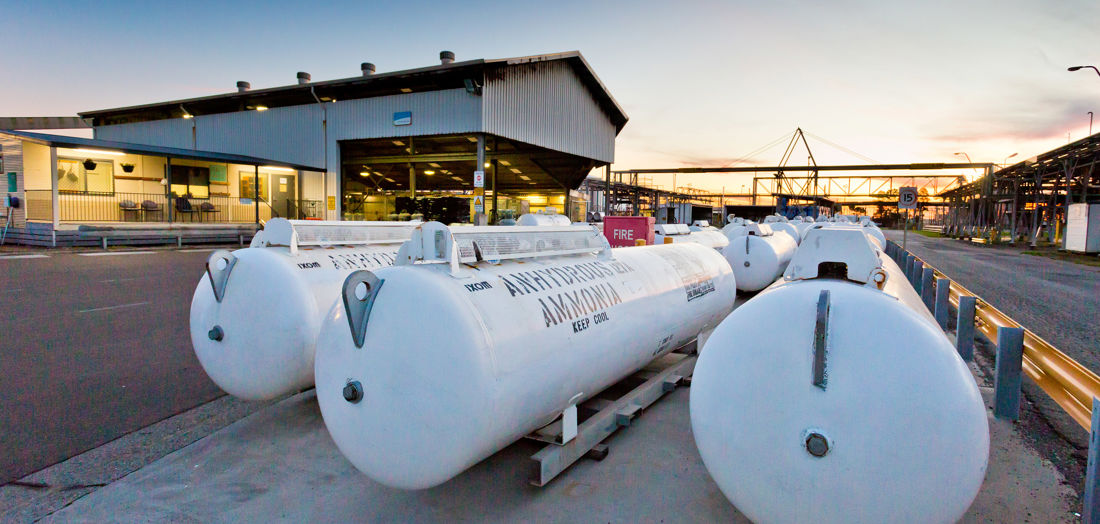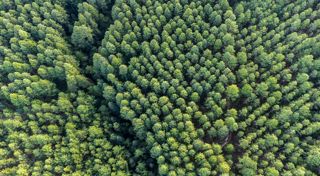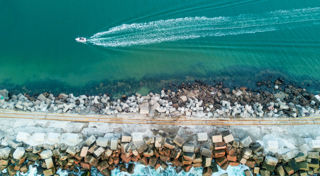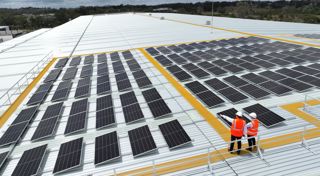Kooragang Island Decarbonisation Project opens

The upgrade of major Australian manufacturer Orica’s processing plants, used in the production of ammonium nitrate, has been successfully completed. Orica is aiming to use the fully operational tertiary nitrous oxide abatement technology to cut greenhouse gas emissions by 48 per cent at the Hunter site. The project is the first time this technology has been used in Australia. The CEFC committed $25 million to the project in 2021, in one of its largest single abatement projects.
Orica media release
13 July 2023
Orica set to eliminate nearly 50 per cent of total greenhouse gas emissions from Hunter Valley site.
World leading mining solutions provider and major Australian manufacturer Orica has today announced the completion of its Kooragang Island Decarbonisation Project in Newcastle, with the successful commissioning of an Australian first technology across its three nitric acid manufacturing plants on site.
A major step in Orica’s journey to decarbonise its operations, the fully operational tertiary abatement technology has reduced greenhouse gas (GHG) emissions released by Orica’s three nitric acid plants by at least 98 per cent.
This is equivalent to 48 per cent of the site's total GHG emissions and 11 per cent of all chemical industry process emissions across Australia. This project will continue to eliminate 567,000 tonnes of carbon dioxide equivalent from the site each year, which is equal to emissions from 50,000 Australian homes.
This is exactly the type of innovation that our safeguard reforms incentivise, helping industrial emitters reduce their emissions while staying competitive. We congratulate Orica investing in technology that helps protect job security for the over 250 employees at the Kooragang Island facility – ensuring they remain competitive in a decarbonising global economy.Chris BowenMinister for Climate Change and Energy
To facilitate the project, the New South Wales Government’s Net Zero Industry and Innovation Program co-invested $13.06 million, together with Orica’s $25 million financed by the Federal Government’s Clean Energy Finance Corporation. The Clean Energy Regulator also approved the project as eligible to generate Australian Carbon Credit Units.
In acknowledging the significant decarbonisation milestone, Orica Managing Director and Chief Executive Officer Sanjeev Gandhi said:
“This project clearly demonstrates that with the right policy settings and corporate commitments, emissions reduction is possible in hard-to-abate industries of our economy.
“The policy certainty from the passage of the Government’s Safeguard reforms means we can now continue to accelerate our decarbonisation plans with confidence. We will continue to invest across our operations, to ensure Australian manufactured products remain competitive as the world transitions to a lower carbon economy. Our focus now moves to decarbonising our operations at Yarwun in Queensland utilising the same proven technology.”
Minister for Climate Change and Energy Chris Bowen commented: “The government is proud to be working in partnership with companies like Orica as they use innovative technology to reduce their emissions,” Minister Bowen said.
“This is exactly the type of innovation that our safeguard reforms incentivise, helping industrial emitters reduce their emissions while staying competitive.
We congratulate Orica investing in technology that helps protect job security for the over 250 employees at the Kooragang Island facility – ensuring they remain competitive in a decarbonising global economy.”
Accelerating towards net zero emissions while establishing Australia’s front running renewable hydrogen and ammonia export industry
Committed to accelerating progress towards its 2050 net zero ambition, Orica has turned its attention to tackling the remaining material greenhouse gas emissions on-site – an initiative that will require a lowcarbon alternative feedstock for ammonia manufacturing. This feedstock will likely come in the form of renewable hydrogen, to replace natural gas feedstock used today. By replacing natural gas with renewable hydrogen, Orica intends to free up domestic gas supply for Australian households.
This project clearly demonstrates that with the right policy settings and corporate commitments, emissions reduction is possible in hard-to-abate industries of our economy.Sanjeev GandhiOrica Managing Director and Chief Executive Officer
Working with Origin Energy on the Hunter Valley Hydrogen Hub (HVHH) to deliver a commercial-scale renewable hydrogen supply chain in the Newcastle industrial and port zone, phase one of the project will produce renewable hydrogen from recycled water and renewable electricity using a grid-connected 55MW electrolyser.
The Hydrogen Hub will be located next to Orica’s Kooragang Island manufacturing site in Newcastle, in recognition of the competitive advantages of a strategic location on the Port of Newcastle and an established end market. It is also the only ammonia plant operating on Australia’s east coast with direct access to a deep-water port and the Port of Newcastle’s Clean Energy Precinct.
Hydrogen manufactured at the facility will be piped to Orica’s manufacturing site where it will be used to replace natural gas in the production of green ammonia and ammonium nitrate – crucial products for many businesses across NSW including the mining, agriculture, health and food industries.
Memorandum of Understanding (MoU) agreements have also been established between Orica, Origin Energy, and the Port of Newcastle to potentially scale up production in subsequent phases of the HVHH development in the Clean Energy Precinct.
In addition to scaling up production, opportunities between the Port of Newcastle and Orica are currently being explored for ammonia storage and a potential domestic and international terminal located on the Clean Energy Precinct. These partnerships will put the ambition for an Australian renewable hydrogen and green ammonia industry with export capability, within reach.
Underscoring the importance of collaboration in realising this project, Mr Gandhi said:
“We’re deeply committed to future-proofing our manufacturing, jobs and economies, maintaining supply chain sovereignty and building a solid foundation for a regional Hydrogen Hub in the Hunter Valley, while also supporting our customers to achieve their sustainability goals.
“However, these projects will take time and significant challenges exist. Collaboration with Government, community, industry, academia and commercial partners will be critical to the success of this project. We believe this will give Australia the best chance at establishing a robust domestic renewable hydrogen and ammonia industry with export and global scale while thriving in a lower carbon world.”
Media release, 2023




